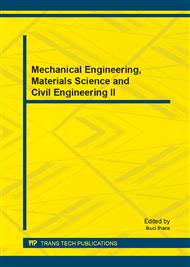[1]
A.S. Veletsos, N.M. Newmark, Effects of Inelastic Behavior on the Response of Simple Systems to Earthquake Motions. Proc. 2nd World Conf. Earthq. Eng., Japan, (1960) Vol. 2, 895-912.
Google Scholar
[2]
N.M. Newmark, W.J. Hall, Seismic design criteria for nuclear reactor facilities, Proc. 4th World Conf. Earthq. Eng., Chile (1969) B-4, 37-50.
Google Scholar
[3]
R. Riddell, N.M. Newmark, Statistical analysis of the response of nonlinear systems subjected to earthquakes, Civil Engineering Studies, Struct. Res. Series No. 468, Univ. of Illinois, Urbana (1979).
DOI: 10.2172/5181570
Google Scholar
[4]
S.P. Lai, J.M. Biggs, Inelastic Response Spectra for Aseismic Buiding Design, ASCE J. Struct. Div. 106, ST6 (1980) 1295-1310.
DOI: 10.1061/jsdeag.0005449
Google Scholar
[5]
S.A. Mahin, V.V. Bertero, An Evaluation of Inelastic Seismic Design Spectra, ASCE J. Struct. Div. 107, ST9 (1981) 1777-1795.
DOI: 10.1061/jsdeag.0005782
Google Scholar
[6]
J. Wu, R.D. Hanson, Study of inelastic spectra with high damping, J. Struct. Eng. 115: 6, (1989) 1412-1431.
DOI: 10.1061/(asce)0733-9445(1989)115:6(1412)
Google Scholar
[7]
H. Sucuoğlu, M. Dicleli and A. Nurtuğ, An analytical assesment of elastic and inelastic response spectra, Can. J. Civ. Eng. 21 (1994) 386-395.
DOI: 10.1139/l94-042
Google Scholar
[8]
S.V. Tolis, E. Faccioli, Displacement design spectra, J, Earthq. Eng. 3 (1999) 107–125.
Google Scholar
[9]
J.J. Bommer, Elnashai A.S. and A.G. Weir, (2000) Compatible acceleration and displacement spectra for seismic design codes. In: Proc. 12th World Conf. Earthq. Eng., New Zealand.
Google Scholar
[10]
F. Naeim, C.A. Kircher, On the damping adjustment factors for earthquake response spectra, Struct. Des. Tall Build. 10: 5 (2001) 361-369.
DOI: 10.1002/tal.180
Google Scholar
[11]
Y.Y. Lin, K.C. Chang, Study on damping reduction factors for buildings under earthquake ground motions, J. Struct. Eng. 129: 2 (2003) 206–214.
DOI: 10.1061/(asce)0733-9445(2003)129:2(206)
Google Scholar
[12]
P.K. Malhotra, Smooth spectra of horizontal and vertical ground motions, Bull. Seism. Soc. Am. 96: 2 (2006) 506-518.
Google Scholar
[13]
D. Cardone, M. Dolce and M. Rivelli, Evaluation of reduction factors for high-damping design response spectra, Bull. Earthq. Eng. 7: 1 (2009) 273-291.
DOI: 10.1007/s10518-008-9097-y
Google Scholar
[14]
Eurocode 8: Design of structures for earthquake resistance. Part 1: General rules, seismic actions and rules for buildings, EN 1998-1: 2004, Doc. CEN/TC250/SC8/N317, European Committee for Standardization, Belgium, (2004).
DOI: 10.3403/03244372u
Google Scholar
[15]
P100-1/2006: Seismic Design Code. Part I. Design Rules for Buildings, Construction Bulletin, 12-13, INCERC, Bucharest, 2006 (in Romanian).
Google Scholar
[16]
I.G. Craifaleanu: Contributions to the study of the inelastic seismic response of reinforced concrete structures. PhD Thesis. Technical University of Civil Engineering Bucharest (1996) (in Romanian).
Google Scholar
[17]
I.G. Craifaleanu: Studies on response modification factors for Vrancea earthquakes. Buletinul AICPS, No. 2 (1998), pp.34-40 (in Romanian).
Google Scholar
[18]
I.G. Craifaleanu, Studies on inelastic response spectra for Vrancea earthquakes. Buletinul AICPS, No. 3 (1999), pp.62-68 (in Romanian).
Google Scholar
[19]
I.G. Craifaleanu: Nonlinear single degree-of-freedom models in earthquake engineering: Bucharest: Matrix Rom (2005) (in Romanian).
Google Scholar
[20]
D. Lungu, T. Cornea, I. Craifaleanu, S. Demetriu: Probabilistic seismic hazard analysis for inelastic structures on soft soils. Proc. 11th World Conf. Earthq. Eng., Mexico, 1996, Paper. No. 1768, Elsevier Science (1996).
Google Scholar


